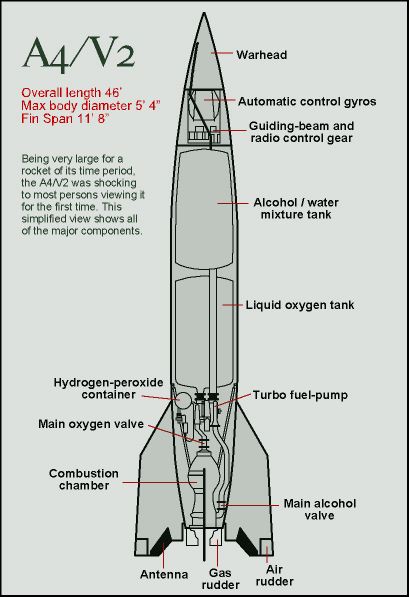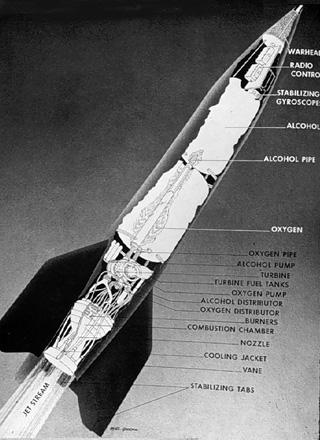
Time Travel Research Center © 2005 Cetin BAL - GSM:+90 05366063183 - Turkey / Denizli

A4/V2 Design & Tech Data
 |
Click here to view a large diagram of the A4/V2 engine systems Before launch, the empty V2 weighs 10,000 lbs (4539 kg), it is filled with fuel, alcohol, liquid oxygen, hydrogen peroxide en sodium permanganate (catalyst). The air batteries and nitrogen batteries are filled up to 200 bar, and the rocket now weighs 28,000 lbs (12700 kg). Electrical cables are now connected and gyroscopes are being powered up by 28 Volts / 60 Amps, DC. The cables are connected till launch, batteries take care of power supply during flight. After everything is set, pressurized air (32 bar) presses the hydrogen peroxide and the sodium permanganate into the 580 HP turbine. This causes the turbine to rotate 3800 per min. This turbine moves two pumps that inject the Methyl alcohol, at 23 bar via 1224 nozzles (58 kg/sec) and liquid oxygen at 17.5 bar via 2160 nozzles (72 kg/sec) into the burn chamber at 23 bar. The mixture is ignited, where a temperature of 2500 degrees Celsius at 15 bar is reached, but is not producing enough impulse to lift the V2. Soon after checking to make sure propulsion is working properly, the burning speed will be raised and cables are disconnected electromagnetically. The V2 engine burn chamber temperature was about 2700 degrees Celsius. This wall is cooled by the liquid ethyl alcohol flowing via the double wall of the beam tube and burning chamber, which also heated up the ethyl alcohol. In the burning process, first oxygen is injected, without entering air, then spontaneous burn of the fuel and liquid oxygen, then gasses flow with great speed to the nozzle end. During burn time (about 60 sec) the V2 is steered by 4 graphite rudders and 4 vanes (at the fins). To describe the steering process, one can imagine the mechanics of the vertical vanes and rudders 1 and 3, and the horizontal vanes and rudders 2 and 4, in this manner. - Vanes and rudders 1 and 3 (react together) control the oscillation and heading in the lateral movement, then the movement in the projectiles along a given axis, which stands perpendicular on the vertical movement by the same along the axis. Rudders 2 and 4 control the oscillation and heading in the vertical movement in the same manner on their axis. Vanes 2 and 4 controls roll stabilization. Vanes 1, 2, 3, and 4 are controlled by a gyroscope. They keep the axis of the V2 vertical. Rudders 2 and 4 are controlled by another gyroscope. They take care of the angle (as from the vertical) of the rocket during burn time. The latter gyroscope is controlled by a third gyroscope that makes sure the first mile will be straight up, after that it is turning until the correct elevation is reached, This elevation is kept until the speed is high enough to reach the target, finally the last gyroscope shuts off fuel supply. After shutdown the rocket acts as a regular artillery shell. Fully fueled, the V2 had 4900 kg A-Stoff which was liquid oxygen with a temperature of minus 183 degrees Celsius, and 3710 kg of a mixture of 75% Ethyl alcohol and 25% water, called B-Stoff. The oxygen evaporated so quickly that the tank truck started at the load station with 6400 kg, so when they arrived at the site for V2 fueling, 1500 kg was already evaporated. The rocket also carried 175 kg of T-Stoff, which was 80% hydrogen, and 22 kg Z-Stoff which was a mixture of 1/3 part sodium permanganate and 2/3 part water. The latter was for propulsion of the 580 horsepower turbine, compressed air pushed those materials with a pressure of 32 bar in this turbine, 385 degrees Celsius vapor brought the turbine to 3800 RPM. Each second, 58 kg alcohol of 23 bars had to be pressed via 1224 injection ports, and 72 kg oxygen with a pressure of 17.5 bars via 2160 injection ports into the burning chamber, that eventually at a pressure of 15 bars brought the temperature to 2500 degrees Celsius. Initial lift pressure was 3 tons, which took 3 seconds (for observation of good ignition) and than raised to 25 tons. For the V2 , 6967 kg raw materials was needed (without the explosives and devices) of which 3112 kg thin sheet metal (various thickness) e.g. the outer skin. Average price of a V2 was 119600 Reichsmark.
The A4/V2 rocket had an operational range of 234 miles. The max. burning time of the engine was 65-70 seconds, shortly before engine shutdown the A4 weighed 4040 kg at a height of 35 km, starting with 1 G force, and at shutdown 8 G, after shutdown the A4 flew to a height of 97 km and fell to earth with a impact speed of 3240-3600 km per hour. Liftoff was straight up; 30 seconds after launch it reached speed of sound. When launched against targets close to the operational range of the vehicle, the deviation between target and impact was normally 4 to 11 miles (7-17 km away from target). This made the rocket only suitable for use against widely populated areas. At shorter targeting ranges, the accuracy of the A4 was improved. The Leitstrahlstellung was a guiding beam that improved accuracy of the A4 somewhat during the later days of the campaign. One quarter of all A4 rockets were guided with the Leitstrahlstellung.
A description of an A4/V2 impact would be as follows. First, a whip cracking sound of a blast wave created by the rocket (moving faster than the speed of sound) bounces off of the point of impact just split seconds before the flash of impact. This was followed by the chaos of the explosion with debris and earth churned skyward. Soon, the whine and rush of whistling air as the sound catches up with the rocket followed by a deafening roar of the incoming rocket, which tapers off to silence. There could be no warning. The A4/V2 impacted at 3 times the speed of sound. The V2 offensive would last from September of 1944 until March of 1945. Over 3000 rockets were launched in this time period. The London area was hit by over 500 rockets and several hundred more dropped in surrounding counties. At first London and Antwerp were the primary targets, but rockets also fell around Ipswich and Norwich, and many Allied held targets in France, Belgium and Holland, and even on Germany itself. Immediately after
the war, the V2 was extensively tested by the British during Operation
Backfire. V2 technology system: |
|
Statistics of
the V2
|
 |

|
| © Brothers Designs Hiçbir yazı/ resim izinsiz olarak kullanılamaz!! Telif hakları uyarınca bu bir suçtur..! Tüm hakları Çetin BAL' a aittir. Kaynak gösterilmek şartıyla siteden alıntı yapılabilir. The Time Machine Project © 2005 Cetin BAL - GSM:+90 05366063183 -Turkiye/Denizli
Ana Sayfa /index /Roket bilimi / Time Travel Technology /Ziyaretçi Defteri /UFO Technology/Duyuru |